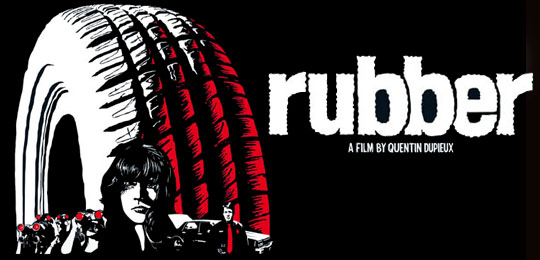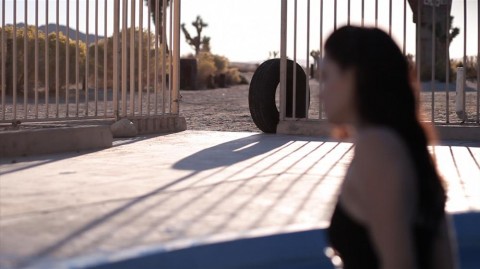Rubber – film review
 “The film you are about to see is an homage to ‘no reason’, that most powerful element of style.”
“The film you are about to see is an homage to ‘no reason’, that most powerful element of style.”
This is the manifesto that opens Rubber, delivered directly to the audience in a breaking of the fourth wall that is somewhat like taking a pound of dynamite to a pane of glass.
Rubber is a “horror” film about a black rubber car tyre that kills people by making their heads explode. With telepathy. And when I say “horror” I do of course mean “side-splittingly funny, pitch black, absurdist comedy.”
Screened at Toronto After Dark, the opening scenes of Rubber are a deliberate assault on the separation between the audience and the film. Normally the opening sequence of a film seeks to bring you into the world of the film; the audience is encouraged to suspend their disbelief, step through the silver screen, and forget about the world their physical bodies might happen to inhabit for the duration of the story. Rubber perverts these expectations. The film comes crashing through the screen, out into the world of the audience. It reminds us at every turn that we are watching a film, and indeed that the very act of our watching is what makes the film happen.
You see, there are actually two plotlines at work in Rubber. The first concerns a murderous inanimate object (our villain), an innocent but spirited young woman on the run from some troubled element of her past (our heroine), and the county sheriff (our hero) on the trail of the vulcanised psychopath. This is ostensibly the core thread of the movie, but we soon see that this action only serves as a literal distraction for the audience, who exist in the film, embodied as actual participants, though ones who remain clearly and distinctly removed from the action, watching events at a distance through field glasses. This distraction covers the real story, that of the sheriff, who is in fact the antagonist of the story, attempting to kill off the audience (through the manoeuvrings of his toady, The Accountant) so that the film can end and he can go home.
The movie within the movie begins with a sequence that could have come straight from Leone’s scrapbook. A man lies face down in a desert. Slowly, he rises, and shakes himself off. He staggers along, and falls. He rises again, and continues to stagger on, through the endless desert. Except that the “man” in question is a rubber tyre (Roger, according to the credits). This is the brilliance of Rubber; that it can appropriate the cinematic language that we are so familiar with, and apply it to situations that cannot be anything but utterly absurd.
Other scenes lift from a variety of sources, including a sequence that takes place in what is clearly the Bates hotel from the original Psycho. For a film that claims to be dedicated to meaninglessness, it is ironic that not a single frame is without a clear purpose. Every shot serves to either ensconce us in the impossible world of a rubber tyre who murders people, or tear us forcibly out of it, as we return repeatedly to the plight of the poor audience, stranded in the desert with no food, and prey to depredations of a murderous cast member, or possibly character. It’s never clear whether the antagonist is an actor who wants to stop playing his role, or a character in a story who wants the story itself to end; the latter appeals, if only for its deeply apocalyptic subtext. When the film ends, where does the character go?).
 Even the choice of the supposed villain, Roger the rubber tyre, must have taken a great deal of thought. It’s such an elegant choice; an object capable of locomotion, but without moving parts to cutely animate. Something that has an element of menace (after all, a tyre, attached to a vehicle, can do a lot of damage), but is also innately ridiculous. An object that can fulfill the emotive needs of the film yet has remarkably little capacity to emote. Consider that all this thing can do is roll forward, roll backwards, fall over, stand up, and vibrate its sides. That’s a sum total of five things you can ask your star to do for you on screen. As a film-making challenge alone, that’s a spectacular feat to undertake.
Even the choice of the supposed villain, Roger the rubber tyre, must have taken a great deal of thought. It’s such an elegant choice; an object capable of locomotion, but without moving parts to cutely animate. Something that has an element of menace (after all, a tyre, attached to a vehicle, can do a lot of damage), but is also innately ridiculous. An object that can fulfill the emotive needs of the film yet has remarkably little capacity to emote. Consider that all this thing can do is roll forward, roll backwards, fall over, stand up, and vibrate its sides. That’s a sum total of five things you can ask your star to do for you on screen. As a film-making challenge alone, that’s a spectacular feat to undertake.
Honestly, there’s so much about this film to dig into. I could go on for days about the tiniest of “seemingly irrelevant but incredibly well thought out” details that litter the film. That Rubber invites such complex readings is a testament to the subtlety that underlies the simple brilliance of the film itself. Whatever you may think about the subtext and meaning of this supposedly meaningless film, it doesn’t really matter if Rubber “means” anything or not, because whatever else it may be, the film is absolutely hilarious. We are talking literal “tears of laughter” funny here; there were moments where I had to seriously consider the possibility that I might strain something from laughing so hard.
This is the heart of why Rubber works so well. Quentin Dupieux provides us with excellent cinematography, full of lingering establishing shots and vivid, often deliberately off-frame close-ups, and the cast all turn in magnificent performances, especially Jack Plotnick, who demonstrates the ability to carry a scene from laugh out loud funny to deeply uncomfortable in a matter of seconds. The script is tightly written, and the humour builds on itself in layers, rising from the initial “What The Fuck?” moments of nervous laughter to the farcical crescendo of the closing scenes, where every element of the film collides in a scene that, if nothing else, will mean that I’ll never look at tricycles the same way again.
I could continue to pick at Rubber, pulling out detail after detail, examining each one in turn to find new facets, new thoughts and revelations, and I have no doubt that I will continue to do so as the film unpacks itself in my mind over the next few days. None of that really matters though; what you need to know is that Rubber is the strangest, funniest, and most dazzlingly original film you will see this year, and considering that Scott Pilgrim vs The World just came out, that’s one hell of an achievement.
[Official Rubber film site]












